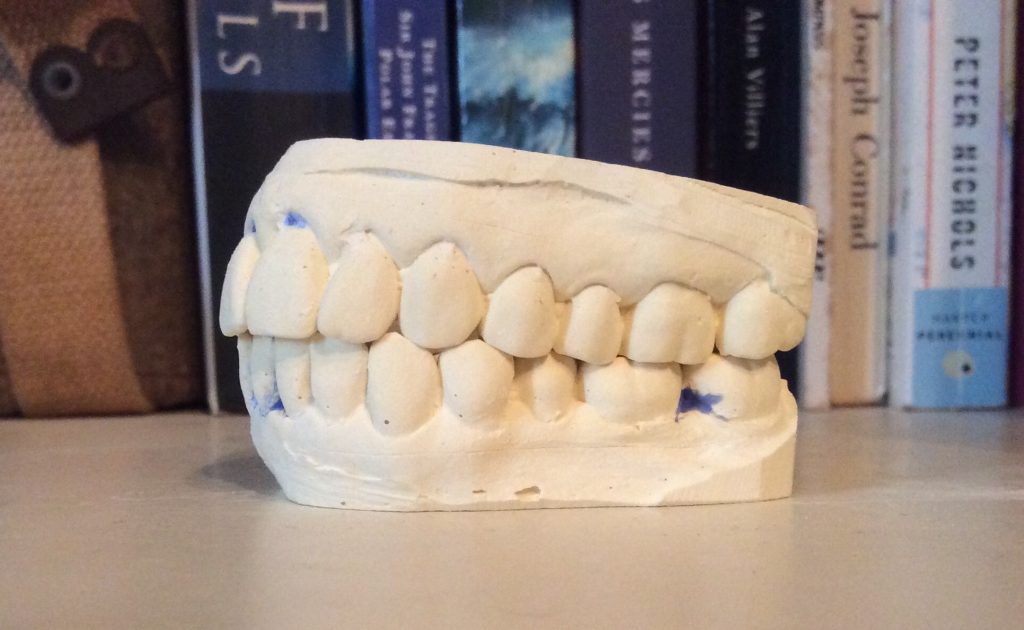I got my first night guard 23 years ago. I remember telling my dentist that I had woken myself up in mid-grind, so I knew I had a problem. He laughed and wondered if this was some kind of Zen thing, like the sound of one hand clapping. It does sound weird. I would imagine that most grinders likely wake up their partner before they wake up themselves. At any rate, I got my night guard. At the time, I was really stressed out at work, drinking four large cups of coffee before noon, and having difficulty sleeping. Thanks to the combination of the night guard, changing jobs, and giving up coffee, I stopped grinding my teeth and put my night guard away in my medicine cabinet.
Fast forward to my last dental checkup when my dentist told me that I have been grinding my teeth at night, and recommended a night guard. I can’t wear my old one because my teeth have shifted (as they do), so I got a new one.

Grinding or clenching your teeth is referred to as bruxing or bruxism. Having a barrier between your upper and lower teeth not only protects the enamel of your teeth and reduces gum recession, but is meant to reduce tension in the muscles of the jaw. This way, the night guard also prevents face and jaw pain. You can get one for the upper or lower teeth. It is not guaranteed to eliminate jaw tension, which means you may end up getting replacement night guards as time goes by.
Can we reduce jaw tension without a device? Yes. Refraining from chewing gum, biting your fingernails, and eating hard foods can all reduce jaw tension and pain. And, thanks to the Alexander Technique, there is another way.
How can Alexander Technique help reduce jaw tension ?
Alexander Technique is a skill that allows us to become more aware of our habitual movement patterns. If one of your habitual patterns is to clench your jaw, you may not even know that you are doing it. That’s how amazing our habits are: they become so much a part of our day-to-day, that we fail to notice them. Most of the time, habits are really wonderful things. We should embrace them and be thankful that we have so many useful patterns at the ready. That is, until we face a habit that is less than optimal, such as, bruxing.
Ok, but what can I do about jaw tension? What do I need to know?
First: You have a jaw, not jaws. You have only one. “Jaws” only refers to the shark movie or the guy in the James Bond films.
Second: The anatomical name of your jaw bone is the mandible. It is shaped like a horseshoe. It connects to your skull via two rounded protuberances that are called condyles. Your upper teeth are attached to your skull.

Third: Your jaw has a resting position. This is technically defined while you are upright (as opposed to lying down) and the condyles of the mandible are “in an unstrained position”. In the rest position, the upper and lower teeth are not in contact, but slightly separated. Your jaw may be at rest while your mouth is closed.
Is your jaw at rest now? Check it out while you are reading this. Allow your lips to close, and, at the same time, consider the possibility that your chewing muscles do not have to contract to hold your jaw in position. Allow there to be space between your upper and lower teeth. Amazingly, there are ligaments that are designed to keep your mandible from falling off, and a certain amount of muscle tone is already present that will keep your mouth from dropping open. Explore your jaw’s resting position when you are lying down, as well.
If you aren’t sure why allowing your jaw to rest would be a good thing, try this simple experiment while you are reading this. Go ahead and gently turn your head from side to side, looking left and right. Come back to centre. Clench your jaw. Try turning your head from side to side while your jaw remains clenched. Notice the difference?
Why is jaw tension a big deal?
F. M. Alexander, the creator of what is now known as the Alexander Technique, discovered that the relationship our head has with our spine is really important and incredibly influential. Because the muscles of the jaw are really close to the muscles that connect our skull to our cervical spine (this is the upper part of the spine, what we call our “neck”), jaw tension and neck tension are deeply intertwined. You discovered this yourself by doing the experiment in the preceding paragraph. If your jaw muscles are engaged, the relationship between your skull and your spine is affected. Movement will become more challenging because you have to overcome the resistance of your jaw and neck muscles that are busy clenching your teeth together. If you free your jaw, you may free your neck as well, and movement becomes easier.
Because we are not conscious when we are sleeping, we cannot actively decide to soften our jaw muscles and choose not to brux at night. However, if we spend time allowing our jaw to rest when we are conscious, our jaw muscles will be less inclined to contract all night. I encourage you to try to explore this as often as you are inspired to do so. It may sound like an intimidating task, noticing one’s jaw all day, but start by noticing it now. Maybe you’ll notice it again in an hour or two. Over time, you will develop an awareness of what your jaw muscles are doing when you are doing other activities. Be curious and be kind to yourself. Jaw tension doesn’t go away overnight. This is a journey: see where it takes you.
